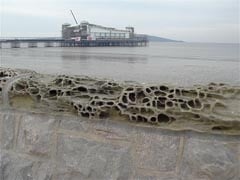The time of tests : salt crystallisation
Led by Europe, more tests are being devised all the time to try to evaluate stone. In this column Barry Hunt explains the tests and discusses what the results show… and what they don’t. This time he looks at salt crystallisation.
The salt crystallisation test used to provoke some of the strongest arguments in the stone industry, when it was believed to be an indicator of stone durability.
Schaffer credits Brard (1828) as being the first exponent of salt crystallisation testing but it was from Schaffer’s work for the Building Research Station (now the BRE) that the current version of the salt crystallisation test was developed. The BRE’s advice on the durability of building stone provided a contentious classification scheme for the test that blighted the use of many stones for many years.
Frost testing has now taken over the mantle of assessing the durability of stone and the controversy has shifted with it (see this column in the previous issue of NSS).
With salt crystallisation we are left with a test that seems a little redundant but actually has some potentially important aspects.
Being an island nation there are many locations along our coastlines and tidal rivers where building stones are subjected to excessive salts. In the most extreme cases, the migration of those salts can destroy the bases of supporting columns, but more generally the construction life will be reduced if stones that are susceptible to salts are used.
The European Standard for resistance to salt crystallisation is EN 12370, which involves immersing dried cubes of stone in a sodium sulfate salt solution for two hours and then drying them for at least 16 hours, raising the temperature to 105ºC by this time. The process is repeated 15 times. At the end of the cycling the samples are placed in water for 24 hours then washed in an attempt to remove as much of the salt as possible. The specimens are dried and the apparent loss in weight determined. If the specimens fall apart before the test cycles have been completed the number of cycles to do this is reported.
The test is extremely difficult to get consistent enough to obtain repeatable results. There have to be precise controls on temperature, humidity, timings and refreshing the solution. This is because much of the damage caused actually occurs during the soaking phase, when dried sodium sulfate salts from the previous cycle are hydrated, leading to considerable internal expansion forces that will tear a weak stone apart.
The test might be better described as a hydration resistance test, but this is being a little pedantic, as it is this type of internal expansive growth that causes serious damage to stone.
The interpretation of what constitutes competent remaining fragments, which may greatly affect the result, is one issue created by those running the test. The selection of a 40mm test cube size is unfortunate as this presents a high surface area for reaction and minimal resistance to internal expansion. In practice, a larger block of stone masonry would not be subjected to such aggressive attack and some stones that might perform well in practice can still fall apart in the test. Apparently the small specimen size was originally chosen to fit into the standard size glass test beakers being used by the BRE when the test was developed. It is a shame that the small size criterion has remained for the current test and a much larger specimen size is not selected.
On the very positive side, the test is aggressive and any stone that gets through it without suffering any significant changes should offer good resistance to salt weathering effects.
For greater assurance with coastal projects the number of cycles can be increased and additional tests may be run using magnesium sulfate or sodium chloride salts instead.
This test really is only appropriate for weaker, porous rock types such as limestones and sandstones and is not really necessary for stronger, non-porous crystalline rocks such as granites.
This is an extremely useful test but one the results of which which must be interpreted with extreme caution.

